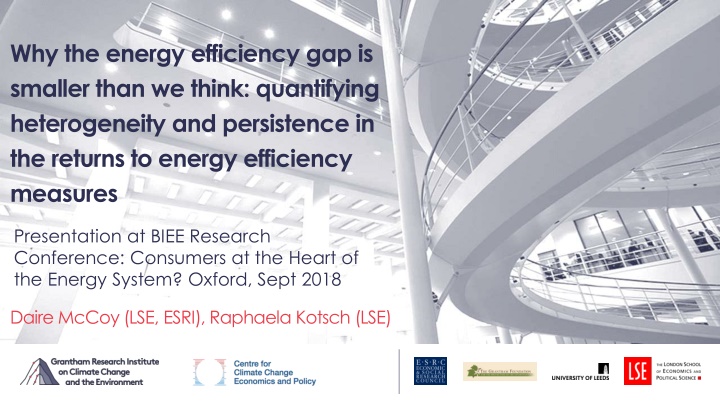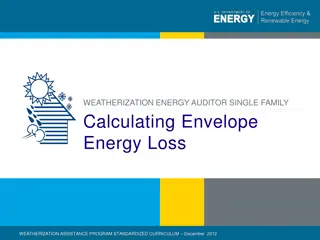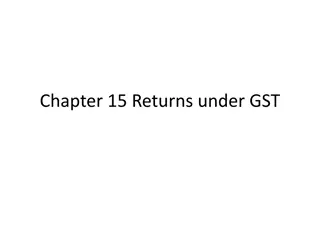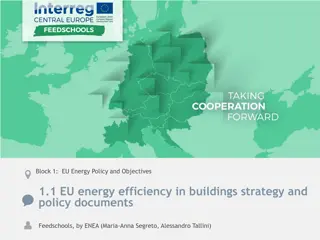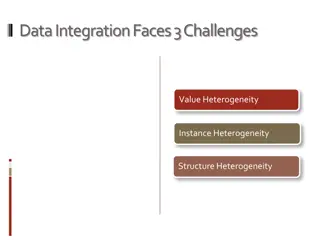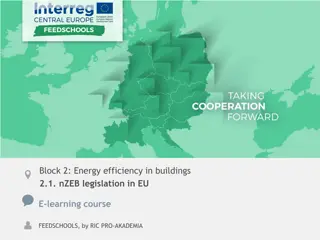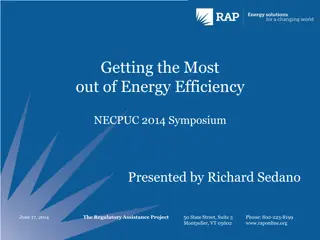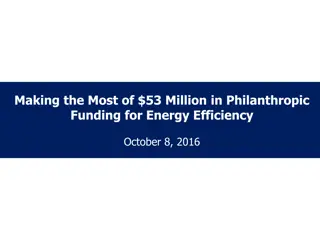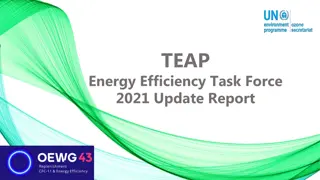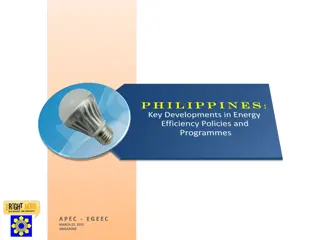Quantifying Heterogeneity in Energy Efficiency Returns
Presentation discussing the smaller energy efficiency gap than perceived, exploring factors such as market failures, consumer heterogeneity, and uncertainty. The research examines the variation in energy savings by measure and household type over time, impacting cost-effectiveness and incentives. Methods include statistical matching and panel econometric estimations on a large household database.
Download Presentation

Please find below an Image/Link to download the presentation.
The content on the website is provided AS IS for your information and personal use only. It may not be sold, licensed, or shared on other websites without obtaining consent from the author.If you encounter any issues during the download, it is possible that the publisher has removed the file from their server.
You are allowed to download the files provided on this website for personal or commercial use, subject to the condition that they are used lawfully. All files are the property of their respective owners.
The content on the website is provided AS IS for your information and personal use only. It may not be sold, licensed, or shared on other websites without obtaining consent from the author.
E N D
Presentation Transcript
Why the energy efficiency gap is smaller than we think: quantifying heterogeneity and persistence in the returns to energy efficiency measures Presentation at BIEE Research Conference: Consumers at the Heart of the Energy System? Oxford, Sept 2018 Daire McCoy (LSE, ESRI), Raphaela Kotsch (LSE)
Introduction and Motivation Fowlie at al. (2018), Allcott and Greenstone (2017) Actual energy savings 40-60 percent of predicted Gerarden at al. (2015) energy efficiency gap Market failures, behavioural failures, model/measurement error Unobserved costs, overstated savings from adoption, consumer heterogeneity, inappropriate discount rates and uncertainty contribute to low adoption rate not being as paradoxical as it first appears Kotchen (2017) long-run effects of building regulations Effects of code change on electricity consumption diminish over time Effects on gas consumption increase over time
Introduction and Motivation Very little work on the longer term effects of energy efficiency measures Despite the long-term savings that they are supposed to deliver Most research estimates short-term savings and makes assumptions about stable returns over longer periods If savings are not stable this could have implications for incentives faced by households; cost-effectiveness of policies; distributional effects of measures
Contribution What we do: Examine how well measures perform Variation in savings by measure and household type Persistence over time Assess how this impacts the cost- effectiveness of measures and incentives faced by households Examine distributional effects How we do it: Analyse a database of four million households over an eight year period Statistical matching and panel econometric estimations to control for unobserved heterogeneity and selection into schemes Population of supplier TWC schemes - mitigate against site selection bias (Allcott, 2015)
Presentation overview 1. Introduction 2. Background 3. Data 4. Methods 5. Results
Background UK Supplier Obligations (Tradeable White Certificates) Principal policy instrument in UK Also widely used in Europe (Italy, France) Hybrid subsidy-tax instrument (Giraudet, 2012) Main features An obligation is placed on energy companies to achieve a quantified target of energy savings Savings are based on standardised ex- ante calculations The obligations can be traded with other obligated parties Market-based flexibility aims to encourage cost-effectiveness Suppliers bear the cost and then pass through to their customers Widely considered to have been cost- effective
Data: National Energy Efficiency Data framework (NEED) NEED Database Annual panel of four million households (2005-2012) Metered gas and electricity consumption Detailed dwelling characteristics Some socioeconomic information
Non-random assignment Selection effects and unobserved heterogeneity FE estimator assumes treatment (upgrade) is strictly exogenous and randomly assigned Selection into scheme is likely correlated with energy consumption, income, location, dwelling quality and other factors... Not taking this into account would bias results Pre-process data using coarsened-exact matching (CEM) to reduce imbalance in observed variables (Iacus, King, and Porro, 2008; Alberini and Towe, 2015) Match on variables most likely to: 1. predict selection into scheme and determinants of energy consumption 2. level and trend of prior year's energy consumption
Overview of Matching Matching estimator mimics random assignment by reducing imbalance in observed variables We match each treatment household with an identical control household
Matching results Level Trend
R2: Heterogeneity in energy savings ATT by measure and IMD group Savings much lower in more deprived areas. Particularly for cavity wall insulation and replacement heating systems
R3: Persistence in energy savings ATT by measure over time Savings relatively stable for cavity wall and loft insulation For replacement heating systems?
R3: Persistence in energy savings ATT for heating systems by IMD group Erosion of savings concentrated in more deprived households (IMD1 and maybe IMD2) Stable for others
How does this impact cost-effectiveness? Internal rate of return (IRR) Cost estimates Cost assumptions ( ) Measure Cavity wall insulation 350 Loft insulation 285 Replacement boiler Lower (policy cost) 200 Where: NPV: net present value T: estimated lifetime of measures Ct: avoided energy costs in year t C0: upfront investment cost r: IRR we solve for Replacement boiler Upper (private cost) Source: Based on Lees (2005, 2008), Shorrock (2005) 2000
Internal rate of return (IRR) IRR for all measures IRR taking erosion of energy savings into account Cavity wall 7% 15% 16% Loft -8% 4% 6% BoilerL 17% 23% 23% BoilerU -24% -7% -2% IRR 10 IRR 20 IRR 30 IMD1 6% -29% IMD2 12% -26% IMD3 16% -23% IMD4 20% -21% IMD5 19% -22% BoilerL BoilerU IRR for all measures by IMD group Sample Average 16% 6% 17% -24% IMD1 11% 5% 12% -26% IMD2 14% 5% 14% -25% IMD3 16% 5% 17% -24% IMD4 17% 7% 20% -23% IMD5 18% 9% 22% -22% Cavity wall Loft BoilerL BoilerU
Overall cost-effectiveness Policies still quite cost-effective per tonne of CO2 36 90 60 600 per kWh 0.0072 0.0171 0.0141 0.1412 Cavity wall insulation Loft insulation Replacement heating (200) Replacement heating (2000) Calculated using Carbon Trust estimates of CO2 per kWh of electricity and gas
Overall cost-effectiveness And compare well internationally Engineering estimates of percent reduction in energy usage Percent reduction in energy usage 2 Cost effectiveness (cents per kWh saved, 2015 USD) 3.6 4.4 1.1 to 1.8 1.2 to 1.8 5.5 2 24.4 3.9 Intervention type Behavioral programs Reference Allcott (2011) Allcott & Rogers (2014) Evaluation type RCT RCT Relevant subset NA One-shot intervention Two-year intervention Four-year intervention Sacramento, California Puget Sound, Washington NA NA Rebate of $1,000 or more Rebate of $450 Rebate of $300 NA Refrigerators Air conditioners Ayres et al. (2012) RCT 2 1.2 1.3 5.3 0 5.5 6.2 Building codes Efficient equipment or energy savings subsidy Novan et al. (2017)c Alberini & Towe (2015) Alberini et al. (2016) RD analysis Matching DID 20 47.9 28.2 Burlig et al. (2017) Davis et al. (2014) Machine learning DID regression 2.9 to 4.5 8 plus 1.7 5.5 9.4 3 11.6 to 18 27.2 4.5 Information provision Supplier Obligation (TWC) Alberini & Towe (2015) McCoy & Kotsch (2018) Matching Matching, FE regression Cavity wall insulation 20.0 5.2 1.54 to 2.31 3.65 to 5.47 Loft insulation Replacement heating system 9.2 24.9 3.02 to 30.19 1.92 Previous estimate of UK Supplier obligation Lees, 2008) Adapted from Gillingham et al (2018)
Conclusions Key findings Standardised assumptions about returns to energy efficiency need to be revised Considerable variation by measure, household type and over time. Savings much less than engineering models predict Savings lower and less persistent for more deprived households Distributional concerns despite explicit targets for deprived households Raises questions about incentive to invest and size of EE gap Policy implications Evaluations need to use actual rather than estimated savings Evaluations need to better quantify non- financial savings. Particularly comfort and health benefits of EESavings lower and less persistent for more deprived households Variation in returns has implications for policy prescription
